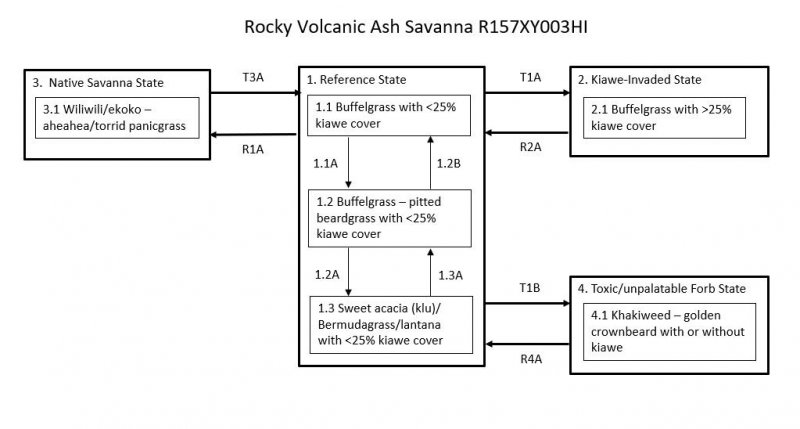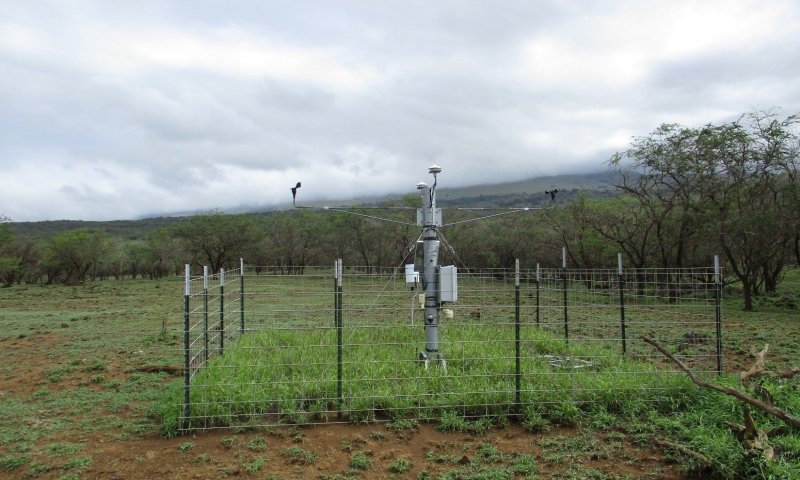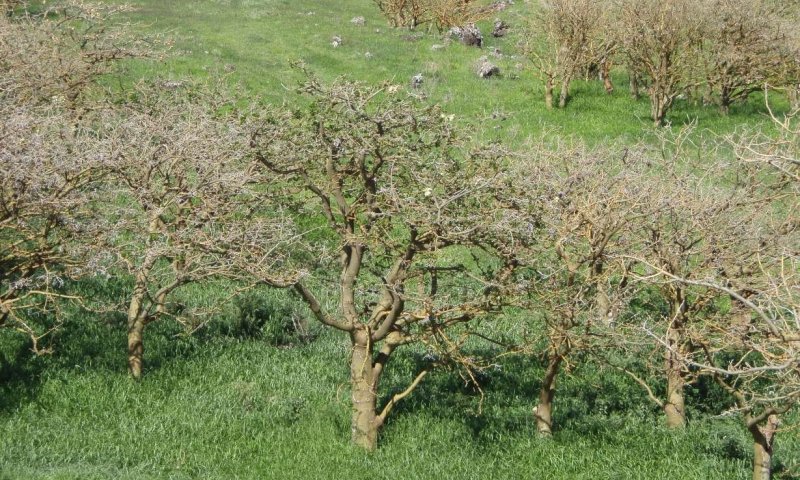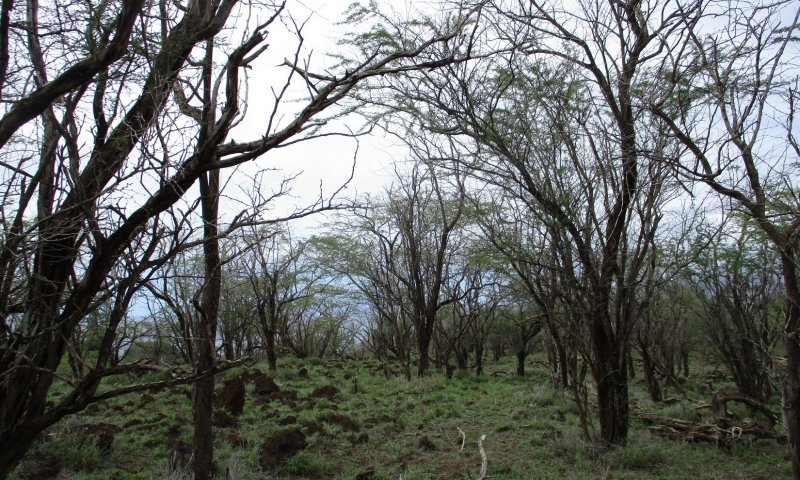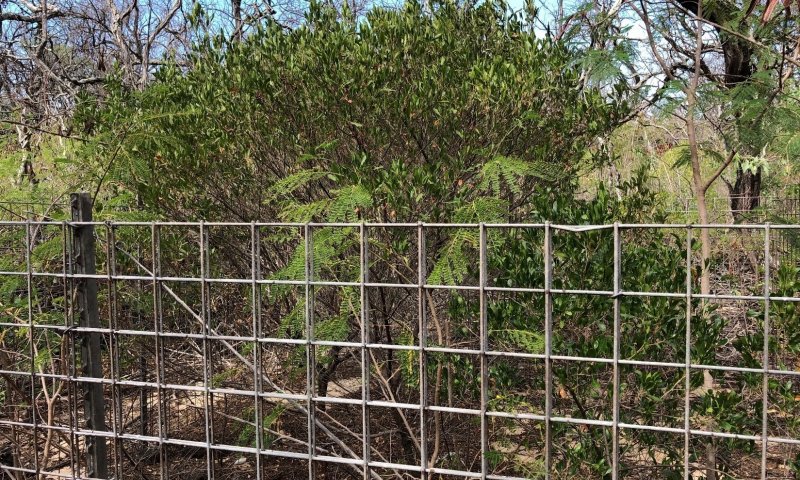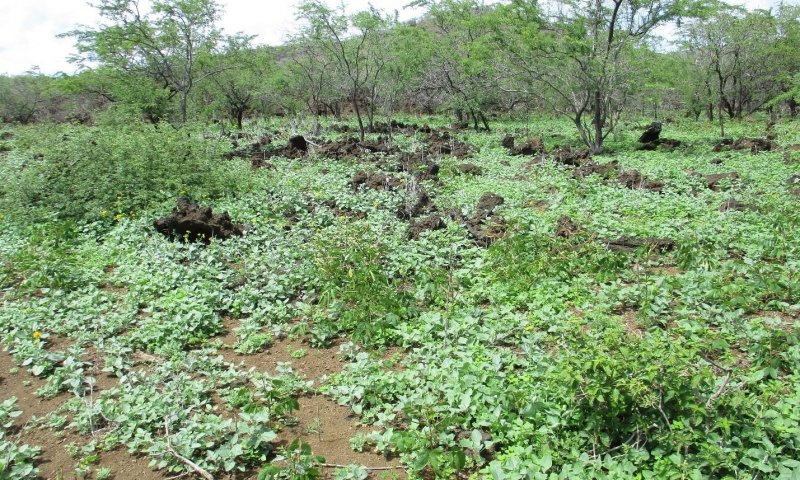

Natural Resources
Conservation Service
Ecological site VX157X01X003
Rocky Volcanic Ash Savanna Kiawe/buffelgrass (Prosopis pallida/Pennisetum ciliare)
Last updated: 5/08/2025
Accessed: 05/20/2025
General information
Provisional. A provisional ecological site description has undergone quality control and quality assurance review. It contains a working state and transition model and enough information to identify the ecological site.
MLRA notes
Major Land Resource Area (MLRA): 157X–Arid and Semiarid Low Mountain Slopes
This MLRA occurs in the State of Hawaii on the islands of Hawaii and Maui. It consists primarily of moderately dissected, gently sloping to steep, leeward mountain slopes. Elevation ranges from sea level to about 6000 feet (0 to 1830 meters). Underlying geology is largely basaltic aa, which is covered by volcanic ash. Climate is dry tropical. Average annual precipitation typically ranges from 10 to 35 inches (255 to 890 millimeters), rising to 45 inches (1145 millimeters) on higher slopes, and mostly occurs from October through May. Much of the rainfall occurs in kona storms during winter. Average annual temperatures range from 55 to 76 degrees F (13 to 24 degrees C), with very little seasonal variation. Soils are mostly Andisols, Mollisols, and Aridisols with isohyperthermic or isothermic soil temperature regimes and ustic or aridic soil moisture regimes. Native vegetation is rare and consists of species characteristic of dry habitats, such as ilima, wiliwili, and aiea. Naturalized grasses such as buffelgrass and kikuyugrass and trees such as kiawe are common.
Classification relationships
This ecological site occurs within Major Land Resource Area (MLRA) 157 - Arid and Semiarid Low Mountain Slopes.
Ecological site concept
This ecological site is largely naturalized grassland on the lower western and southern slopes of Haleakala on the island of Maui and the lower western slope of Kohala and Mauna Kea on the island of Hawaii, the rain shadows of these mountains. Most of the area is owned by the State of Hawaii and Division of Hawaiian Homelands, but parts are on private ranches and other private holdings. On Maui, examples of this ecological site can be seen from Route 37 Piilani Highway and the part of Route 31 that goes through Kihei and Wailea. On Hawaii, examples can be seen along the northern end of Route 19, including at Spencer Beach State Park, and along Route 270, including at Mahukona Beach Park.
The central concept of the Rocky Volcanic Ash Savanna is of well drained, deep and very deep Andisols, moderately deep or deep Aridisols, and shallow Mollisols formed in deposits of volcanic ash deposited over aa lava flows. This Ecological Site occurs on lava flows that are within a range of 50,000 up to 900,000 years old with a few exceptions. Annual air temperatures and rainfall are associated with very warm (isohyperthermic), seasonally dry (aridic or aridic/ustic intergrade) soil conditions. High rock contents (stony, very stony, extremely stony) and/or coarse textures in the soils reduce their plant available water holding capacity in usually coarse-textured surface horizons but, by reducing soil content per unit volume, allow water to infiltrate deep into the soil for storage in finer-textured subsurface horizons. Elevations range from sea level (0 meters) to about 2000 feet (615 meters).
Associated sites
| VX157X01X008 |
Rocky Isothermic Naturalized Grassland Koa haole/guineagrass - buffelgrass/glycine (Leucaena leucocephala/Urochloa maxima - Cenchrus ciliaris/Neonotonia wightii) The Rocky Isothermic Naturalized Grassland occurs only on the island of Maui. It forms part of the upper-elevation boundary of the Rocky Volcanic Ash Savanna on Maui. It has a cooler soil temperature regime (isothermic), moister soil moisture regime (mostly ustic versus torric), greater average annual rainfall (15 to 40 versus 7 to 20 inches), occupies higher elevations (1000 to 2600 versus 0 to 2200 feet), supports native dry forest rather than savanna and shrubland, and has a different dominant forage grass species (guineagrass versus buffelgrass) compared to the Rocky Volcanic Ash Savanna. Due to the moister conditions, soils in the Rocky Isothermic Naturalized Grassland are more weathered (Mollisols, Andisols, and a Histosol) than the Aridisols and Andisols in the Rocky Volcanic Ash Savanna. |
|---|---|
| VX160X01X503 |
Isothermic Forest The Isothermic Forest occurs only on the island of Hawaii. It adjoins the eastern, upper-elevation border of the Rocky Volcanic Ash Savanna. It has a cooler soil temperature regime (isothermic versus isohyperthermic), moister soil moisture regime (mostly ustic versus torric), greater average annual rainfall (20 to 40 versus 7 to 20 inches), supports native dry forest rther than savanna and shrubland, and has a different dominant forage grass species (kikuyugrass versus buffelgrass) compared to the Rocky Volcanic Ash Savanna. Both sites have soils that formed in volcanic ash. |
| VX157X01X004 |
Alluvial Woodland (Kiawe/Prosopis pallida) The Alluvial Woodland occurs only on the island of Hawaii. It is situated at the coast from 0 to 50 feet elevation, where it has received alluvium from higher areas via drainageways within the surrounding Rocky Volcanic Ash Savanna. It receives lower average annual rainfall (7 to 10 versus 7 to 20 inches) than the Rocky Volcanic Ash Savanna and receives occasional, very brief flooding. Most importantly, it has a deep water table accessible to the roots of kiawe trees, resulting in a kiawe woodland rather than a tree/grass savanna. |
| VX158X01X401 |
Isohyperthermic Ustic Naturalized Grassland Koa haole/guineagrass/glycine (Leucaena leucocephala/Urochloa maxima/Neonotonia wightii) The Isohyperthermic Ustic Naturalized Grassland occurs on the islands of Hawaii, Maui, Molokai, Lanai, Oahu, and Kauai. It forms the northeastern boundary of the Rocky Volcanic Ash Savanna on the island of Hawaii where average annual rainfall increases rapidly to the northeast due to atmospheric moisture curving around the northern end of Kohala Volcano. It has the same soil temperature regime (isohyperthermic although a few degrees F cooler), moister soil moisture regime (mostly ustic versus torric), greater average annual rainfall (20 to 60 versus 7 to 20 inches), supports native dry forest rather than savanna and shrubland, and has a different dominant forage grass species (guineagrass versus buffelgrass) compared to the Rocky Volcanic Ash Savanna. Due to the moister conditions and, in places, greater geologic age, soils in the Isohyperthermic Ustic Naturalized Grassland are more weathered (mostly Mollisols, Oxisols, and Ultisols) than the Aridisols and Andisols in the Rocky Volcanic Ash Savanna. |
| VX161A01X001 |
Isohyperthermic Desert The Isohyperthermic Desert occurs only on the island of Hawaii on flows emanating from Mauna Loa rather the Kohala or Mauna Kea flows of the Rocky Volcanic Ash Savanna. It adjoins the southern border of the Rocky Volcanic Ash Savanna on Hawaii. These two ecological sites share soil temperature regimes (although the Isohyperthermic Desert has higher soil temperatures) and soil moisture regimes and have very similar rainfall, and elevations. Both have soils primarily formed in volcanic ash, but soils in the Isohyperthermic Desert range from shallow to moderately deep compared to moderately deep to very deep in the Rocky Volcanic Ash Savanna. Plant species are similar in both sites, although the Isohyperthermic Desert currently has shared dominance of buffelgrass and crimson fountaingrass. This is likely due to the origination point and rate of spread of fountaingrass rather than any other factors. |
| VX158X01X004 |
Rocky Isohyperthermic Torric Naturalized Grassland Kiawe/uhaloa/buffelgrass (Prosopis pallida/Waltheria indica/Pennisetum ciliare) The Rocky Isohyperthermic Torric Naturalized Grassland occurs on Maui, Molokai, and Kauai. It adjoins part of the Rocky Volcanic Ash Savanna on Maui. These two ecological sites share soil temperature and moisture regimes and have very similar rainfall, elevations, and vegetation. Due to moderately to much older substrates, soils in the Rocky Isohyperthermic Torric Naturalized Grassland are mostly Mollisols rather than the Andisols or Aridisols occuring in the Rocky Volcanic Ash Savanna. |
Similar sites
| VX157X01X001 |
Torric Naturalized Grassland The Torric Naturalized Grassland occurs only on the island of Hawaii. It has the same soil temperature regime (isohyperthermic), soil moisture regime (torric), greater average annual rainfall (15 to 30 versus 7 to 20 inches), lower elevation range (0 to 1000 versus 0 to 2000 feet), and supports native grassland and shrubland rather than savanna and shrubland. The two site share the same dominant forage grass species (buffelgrass), but the Torric Naturalized Grassland has very little kiawe, unlike the Rocky Volcanic Ash Savanna. This is likely due to the extreme windiness of the Torric Naturalized Grassland and the lack of finer-textured subsurface horizons to store water for deep-rooted kiawe that depend on that moisture source in order to compete. |
|---|---|
| VX166X01X001 |
Isohyperthermic Torric Naturalized Grassland The Isothermic Torric Naturalized Grassland is on the islands of Oahu, Molokai, and Lanai. It has the same soil temperature regime (isohyperthermic), same soil moisture regime (torric), similar average annual rainfall, lower elevation range (0 to 400 feet versus 0 to 2000 feet), and supports similar vegetation compared to the Rocky Volcanic Ash Savanna The ecological sites share buffelgrass as a potential dominant forage grass species. The soils in the Isohyperthermic Torric Naturalized Grassland are mostly formed in alluvium and are older and more weathered, although some soils are Andisols as in the Rocky Volcanic Ash Savanna. |
| VX163X01X001 |
Shrink-Swell Clay The Naturalized Grassland 15 to 30 Inch Precipitation Zone is on the islands of Oahu and Kauai. It has the same soil temperature regime (isohyperthermic), same soil moisture regime (mostly torric), greater average annual rainfall (15 to 35 versus 7 to 20 inches), lower elevation range (0 to 400 versus 0 to 2000 feet), and supports similar vegetation compared to the Rocky Volcanic Ash Savanna. The ecological sites share buffelgrass as a potential dominant forage grass species. The soils in the Naturalized Grassland 15 to 30 Inch Precipitation Zone are older and more weathered (mostly Mollisols and Aridisols) than the Andisols in the Rocky Volcanic Ash Savanna. |
| VX158X01X002 |
Isohyperthermic Torric Naturalized Grassland Kiawe/buffelgrass (Prosopis pallida/Pennisetum ciliare) The Isohyperthermic Torric Naturalized Grassland is on the islands of Maui, Molokai, Lanai, and Kauai. It has the same soil temperature regime (isohyperthermic), soil moisture regime (torric), greater average annual rainfall (10 to 40 versus 7 to 20 inches), particularly on Kauai, similar elevation range, and supports similar plant species compared to the Rocky Volcanic Ash Savanna. The ecological sites share buffelgrass as a potential dominant forage grass species. The soils in the Isohyperthermic Torric Naturalized Grassland are older and more weathered (mostly Mollisols and Oxisols) than the Andisols in the Rocky Volcanic Ash Savanna. |
| VX158X01X004 |
Rocky Isohyperthermic Torric Naturalized Grassland Kiawe/uhaloa/buffelgrass (Prosopis pallida/Waltheria indica/Pennisetum ciliare) The Rocky Isohyperthermic Torric Naturalized Grassland is on the islands of Maui, Molokai, and Kauai. It has the same soil temperature regime (isohyperthermic), the same soil moisture regime (mostly torric), similar average annual rainfall, and different Soil Orders (mostly Mollisols versus Andisols), and supports similar vegetation compared to the Rocky Volcanic Ash Savanna. The ecological sites share buffelgrass as a potential dominant forage grass species. |
Table 1. Dominant plant species
| Tree |
(1) Prosopis pallida |
|---|---|
| Shrub |
Not specified |
| Herbaceous |
(1) Pennisetum ciliare |
Legacy ID
R157XY003HI
Click on box and path labels to scroll to the respective text.
Ecosystem states
| T1A | - | Succession State 1 Reference transitions to State 2 Kiawe Invaded in the absence of disturbance such as fire or brush management. |
|---|---|---|
| R1A | - | Restoration State 1 Reference transitions and is maintained to State 3 Native Savanna with significant management inputs. The site must be fenced to exclude all domestic and feral ungulates. A firebreak must be established and maintained around the fence line by grazing or mowing. Buffelgrass and other non-native vegetation must be killed, followed by plantings of native trees, shrubs, and vines. Supplemental irrigation may be necessary in the early stages of restoration. |
| T1B | - | Long-Term Systematic Herbivory State 1 Reference transitions and is maintained to State 4 Toxic/Unpalatable Forb primarily by constant heavy browsing and grazing by feral goats and on Maui, deer. |
| R2A | - | Land Clearing, Fire State 2 Kiawe Invaded transitions to State 1 Reference when kiawe are cleared by fire, herbicidal application, or mechanical means. While wildfire will kill kiawe, prescribed burning is typically not done in Hawaii due to the level of risk to relict native ecosystems and enjoined or embedded development. Once cleared, additional brush management strategies to avoid introduction of invasive shrubs (lantana, klu, koa-haole, etc) will be required and prescribed grazing strategies allowing for sufficient rest of perennial grasses and forbs will be needed. |
| T3A | - | Land Clearing by Fire, Ungulate Disturbance, or Mechanical Means State 3 Native Savanna transitions to State 1 Reference when it is cleared by fire, long-term ungulate disturbance, or mechanical means. While wildfire will clear most native vegetation, prescribed burning is typically not done in Hawaii due to the level of risk to enjoined or embedded relict native ecosystems and development. Desired perennial grass and forbs (typically naturalized forage species) are then re-established. |
| R4A | - | Reclamation State 4 Toxic/Unpalatable Forb transitions to State 1 Reference with significant management inputs. Management and significant reduction in the numbers of the feral animals in the area is necessary. This may involve fencing, trapping, and other herd reduction methods. The soil seed bank will probably bring back a variety of plant species in a favorable weather year but seeding of desired forages or native plants is recommended, along with continuous weed and brush control as necessary. Sites that are severely eroded may require additional management inputs and conservation practices. |
State 1 submodel, plant communities
| 1.1A | - | Phase 1.1 can change to phase 1.2 with continuous grazing. Buffelgrass cover and vigor are reduced by continuous grazing, causing it to decrease and be partially replaced by pitted beardgrass. The application of prescribed grazing and a planned grazing system allowing for sufficient plant rest of forage species are expected to cause this community to remain intact. |
|---|---|---|
| 1.2B | - | Phase 1.2 can change to phase 1.1 by application of a prescribed grazing program that allows buffelgrass to reassume dominance. Apply brush management and weed control as necessary. |
| 1.2A | - | Phase 1.2 changes to phase 1.3 with long-term and/or heavy continuous grazing. Species composition changes to dominance by short grasses, weedy forbs, and shrubs. Bare ground increases markedly. With implementation of prescribed grazing and a planned grazing system, this shift is not expected to occur. It is likely that brush management and weed control will be needed. |
| 1.3A | - | Phase 1.3 can change to phase 1.2 by application of a prescribed grazing program that allows buffelgrass to reassume dominance. Intensive weed and brush control may be necessary. Measures to control wind and water erosion may also be needed. |
